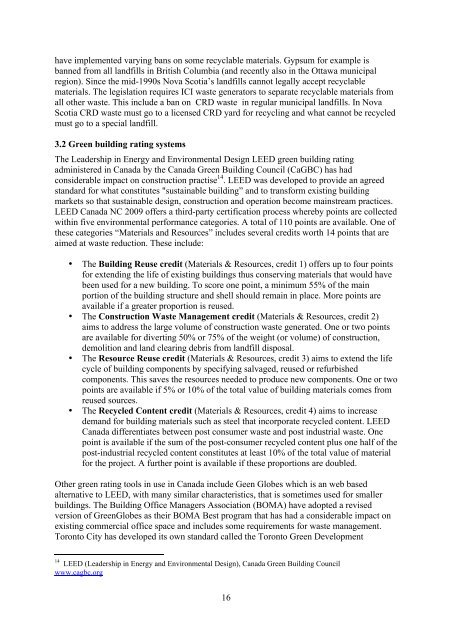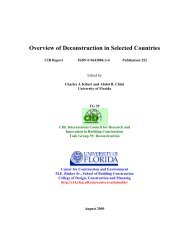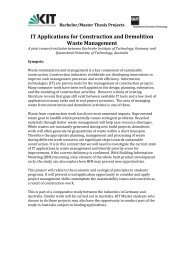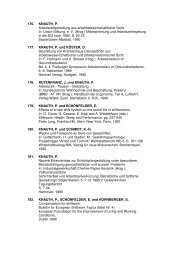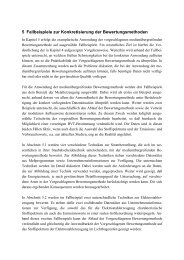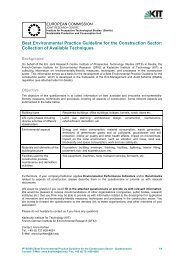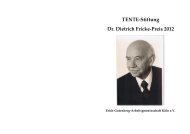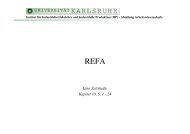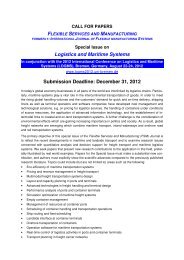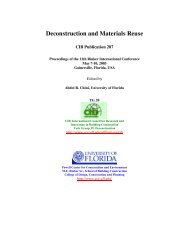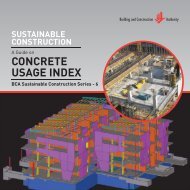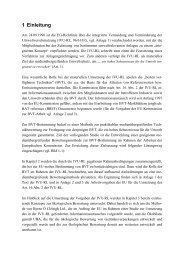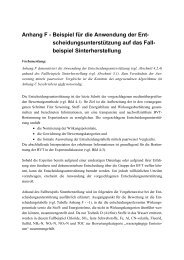Waste reduction final report -4 - Test Input
Waste reduction final report -4 - Test Input
Waste reduction final report -4 - Test Input
You also want an ePaper? Increase the reach of your titles
YUMPU automatically turns print PDFs into web optimized ePapers that Google loves.
have implemented varying bans on some recyclable materials. Gypsum for example is<br />
banned from all landfills in British Columbia (and recently also in the Ottawa municipal<br />
region). Since the mid-1990s Nova Scotia’s landfills cannot legally accept recyclable<br />
materials. The legislation requires ICI waste generators to separate recyclable materials from<br />
all other waste. This include a ban on CRD waste in regular municipal landfills. In Nova<br />
Scotia CRD waste must go to a licensed CRD yard for recycling and what cannot be recycled<br />
must go to a special landfill.<br />
3.2 Green building rating systems<br />
The Leadership in Energy and Environmental Design LEED green building rating<br />
administered in Canada by the Canada Green Building Council (CaGBC) has had<br />
considerable impact on construction practise 14 . LEED was developed to provide an agreed<br />
standard for what constitutes "sustainable building” and to transform existing building<br />
markets so that sustainable design, construction and operation become mainstream practices.<br />
LEED Canada NC 2009 offers a third-party certification process whereby points are collected<br />
within five environmental performance categories. A total of 110 points are available. One of<br />
these categories “Materials and Resources” includes several credits worth 14 points that are<br />
aimed at waste <strong>reduction</strong>. These include:<br />
• The Building Reuse credit (Materials & Resources, credit 1) offers up to four points<br />
for extending the life of existing buildings thus conserving materials that would have<br />
been used for a new building. To score one point, a minimum 55% of the main<br />
portion of the building structure and shell should remain in place. More points are<br />
available if a greater proportion is reused.<br />
• The Construction <strong>Waste</strong> Management credit (Materials & Resources, credit 2)<br />
aims to address the large volume of construction waste generated. One or two points<br />
are available for diverting 50% or 75% of the weight (or volume) of construction,<br />
demolition and land clearing debris from landfill disposal.<br />
• The Resource Reuse credit (Materials & Resources, credit 3) aims to extend the life<br />
cycle of building components by specifying salvaged, reused or refurbished<br />
components. This saves the resources needed to produce new components. One or two<br />
points are available if 5% or 10% of the total value of building materials comes from<br />
reused sources.<br />
• The Recycled Content credit (Materials & Resources, credit 4) aims to increase<br />
demand for building materials such as steel that incorporate recycled content. LEED<br />
Canada differentiates between post consumer waste and post industrial waste. One<br />
point is available if the sum of the post-consumer recycled content plus one half of the<br />
post-industrial recycled content constitutes at least 10% of the total value of material<br />
for the project. A further point is available if these proportions are doubled.<br />
Other green rating tools in use in Canada include Geen Globes which is an web based<br />
alternative to LEED, with many similar characteristics, that is sometimes used for smaller<br />
buildings. The Building Office Managers Association (BOMA) have adopted a revised<br />
version of GreenGlobes as their BOMA Best program that has had a considerable impact on<br />
existing commercial office space and includes some requirements for waste management.<br />
Toronto City has developed its own standard called the Toronto Green Development<br />
14 LEED (Leadership in Energy and Environmental Design), Canada Green Building Council<br />
www.cagbc.org<br />
16


